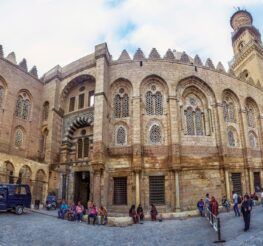Al Silahdar Mosque: Captivating Architectural Landmark in El Muez Street

Ahmed Abd El Gawad
Boasting some of the most beautiful Islamic landmarks in Egypt’s history, it’s hard not to feel a certain sense of grand nostalgia at the sight of El Muez Street’s architectural treasures. Taking a stroll down to the one-kilometer street, Al Silahdar Mosque, a beautiful mosque dating back to Mohamed Ali Pasha’s ruling, stands as one of the most stunning buildings in the area – maybe even in the whole of Cairo.
Named after its founder, Al Silahdar mosque was designed in 1839 by Sulayman Agha Al Silahdar;a lieutenant during the reign of Mohamed Ali, who built many grandiose structures during his rule.
Situated between Abu Bakr Muzhir Mosque – built by religious scholar, Zayn El Din Abu Bakr Ibn Muzhir, during the Mamluk era – and Beit El Suheimi – the gorgeous Ottoman building now used as a cultural centre of sorts – our destination is in very good company.
The entry to the mosque as such; a huge pathway leads you to a granite staircase, which in turn takes you to the main doors. Call us soppy, but Al Silahdar Mosque will instantly transport you back in time to the Mamluk era; its rectangular construct is divided into two large squares, with the western corner of the mosque featuring the mosque’s courtyard – the unroofed open-air area of the mosque — which gets occasionally covered by a wooden roof to protect the building from the rain. Al Silahdar’s courtyard is concealed by four corridors covered with beautiful small domes based on marble pillars. Each dome is adorned with multi-coloured carvings, architectural drawings and Quranic inscriptions all made with oil paints.
The eastern corner of the mosque, meanwhile, is where the praying area is situated and is divided to three main hallways parallel to the Qibla (the direction of the Kaaba to which Muslims pray). The praying area is covered with a wooden roof boasting wonderful oil-painted carvings and right in the middle of it, lays an impressively carved Minbar made of marble, where the mosque’s Imam stands during sermons.
The architecture and configuration of Al Silahdar Mosque features elements inspired by the Ottoman Empire; however, the design also fuses elements of Cairo’s own distinctive architectural features, as well as elements from the Baroque era which can be seen in the mosque’s pillars.
Egypt is blessed with many historic landmarks, but Al Silahdar Mosque stands as one of Cairo’s most intriguing attractions in terms of design and history. Visiting El Muez Street during dusk-hours is highly recommended; the sunset, along with the breathtaking lightings reflecting the beauty of the mosques at night, is quite a sight.
recommended
 Arts & Culture
Arts & Culture
The Coptic Museum: The History of Egypt to the Tunes of Psalms of David
arts & culture cairo museums +4 Health & Fitness
Health & Fitness
Egyptians in the 2024 Summer Olympics
Egyptians in the Olympics Olympics +1 City Life
City Life
Weekend Guide: Bazar by Sasson, Memo, The Cadillacs, Heya Bazaar, Dou, Nesma Herky & More
Concerts The Weekend Guide +2 Arts & Culture
Arts & Culture

